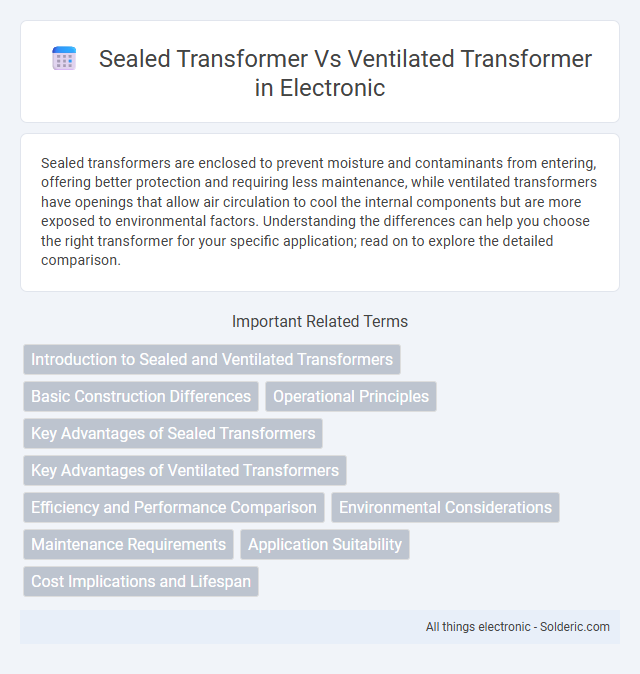Sealed transformers are enclosed to prevent moisture and contaminants from entering, offering better protection and requiring less maintenance, while ventilated transformers have openings that allow air circulation to cool the internal components but are more exposed to environmental factors. Understanding the differences can help you choose the right transformer for your specific application; read on to explore the detailed comparison.
Comparison Table
| Feature | Sealed Transformer | Ventilated Transformer |
|---|---|---|
| Enclosure Type | Hermetically sealed | Vented with air circulation |
| Cooling Method | Oil-immersed, sealed cooling | Natural or forced air ventilation |
| Maintenance | Low, no oil refilling | Higher, requires ventilation and cleaning |
| Environmental Protection | High, protects from moisture and contaminants | Lower, open to external environment |
| Application | Indoor/Outdoor in harsh environments | Indoor or mild outdoor conditions |
| Cost | Higher initial cost | Lower initial cost |
| Reliability | Higher due to better protection | Moderate, depends on ventilation quality |
Introduction to Sealed and Ventilated Transformers
Sealed transformers are enclosed units designed to prevent the ingress of moisture and contaminants, enhancing durability and reliability in harsh environments. Ventilated transformers feature external cooling vents or radiators to dissipate heat more effectively, making them suitable for higher power applications. Your choice depends on factors like operating conditions, cooling requirements, and maintenance preferences.
Basic Construction Differences
Sealed transformers feature a hermetically closed tank design that prevents moisture, dust, and contaminants from entering, ensuring long-term insulation reliability. Ventilated transformers have externally exposed radiators or fans to facilitate air circulation, promoting better cooling but requiring more maintenance due to exposure. Your choice depends on the installation environment and cooling efficiency needs, with sealed transformers ideal for harsh or indoor settings and ventilated units suited for outdoor applications where airflow aids heat dissipation.
Operational Principles
Sealed transformers operate by housing the core and windings within a completely enclosed casing, preventing exposure to external air and contaminants, which enhances insulation longevity and reduces maintenance. Ventilated transformers incorporate external vents or fans to facilitate heat dissipation and air circulation, leveraging natural or forced airflow to maintain optimal operating temperatures. The operational principle of sealed transformers prioritizes containment and protection, while ventilated transformers focus on active cooling through environmental interaction.
Key Advantages of Sealed Transformers
Sealed transformers offer enhanced protection against dust, moisture, and environmental contaminants, significantly increasing their durability and reducing maintenance requirements. Their airtight design minimizes the risk of insulation degradation, leading to longer operational life and improved reliability in harsh or outdoor conditions. Sealed transformers also provide better safety by preventing oil leaks and reducing fire hazards compared to ventilated transformers.
Key Advantages of Ventilated Transformers
Ventilated transformers offer superior heat dissipation compared to sealed transformers, enhancing operational efficiency and extending equipment lifespan. The design allows for better cooling performance through airflow, reducing the risk of overheating and ensuring stable voltage regulation under varying load conditions. This results in lower maintenance costs and increased reliability in demanding industrial and commercial applications.
Efficiency and Performance Comparison
Sealed transformers typically offer better efficiency in environments with contaminants or moisture, as their enclosed design prevents insulation degradation and prolongs lifespan. Ventilated transformers generally provide superior cooling through air circulation, enhancing performance during high load conditions but may incur efficiency losses in dusty or humid environments. Your choice between sealed and ventilated transformers should consider operational conditions to optimize both efficiency and long-term performance.
Environmental Considerations
Sealed transformers offer superior environmental protection by preventing the ingress of moisture, dust, and contaminants, reducing the risk of oil leaks and equipment failure. Ventilated transformers, while typically easier to cool, may allow external elements that can degrade insulation and increase maintenance requirements over time. Your choice impacts both environmental safety and operational reliability, with sealed designs favored in sensitive or harsh environments to minimize ecological impact.
Maintenance Requirements
Sealed transformers require minimal maintenance due to their enclosed design that prevents contaminants and moisture from entering, reducing the risk of insulation degradation. Ventilated transformers need regular inspections and cleaning to ensure the cooling air pathways remain unobstructed, which is crucial for preventing overheating and extending operational life. Maintenance of ventilated transformers also involves checking fans or other cooling components for proper operation, increasing overall upkeep efforts compared to sealed transformers.
Application Suitability
Sealed transformers are ideal for indoor applications requiring protection from dust, moisture, and contaminants, making them suitable for sensitive environments like medical equipment or telecommunications. Ventilated transformers, with their open design and enhanced cooling, are better suited for outdoor or industrial settings where heat dissipation is critical and exposure to environmental elements is less controlled. Your choice depends on the operating environment, with sealed transformers offering reliability in clean, controlled areas and ventilated transformers providing efficient cooling in harsh conditions.
Cost Implications and Lifespan
Sealed transformers generally incur higher initial costs due to their enhanced insulation and protection against environmental contaminants, but they offer extended lifespan by minimizing moisture ingress and oxidation. Ventilated transformers are typically less expensive upfront, relying on air cooling that can reduce operational efficiency and increase maintenance needs, potentially shortening their service life. Your choice between sealed and ventilated transformers should factor in long-term cost savings versus initial investment to optimize overall performance and durability.
sealed transformer vs ventilated transformer Infographic

 solderic.com
solderic.com